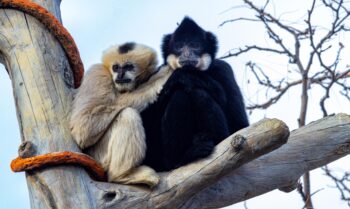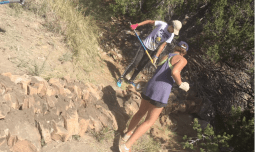January 9, 2019
Denver Zoo’s Vet Med Team Hits the Road to Protect Wildlife
From New Mexico to Mongolia, the Zoo’s Veterinary Medical Team Traveled Far and Wide Last Year in the Name of Conservation
When you visit Denver Zoo, there’s a good chance you’ll see members of our veterinary team caring for any of our more than 3,300 animals. But the Zoo isn’t the only place they spend their days helping wildlife…not by a mile. Or even thousands of miles. Our veterinarians and veterinary technicians are dedicated to the wellbeing and survival of wildlife, whether it’s here on our 84 acres, or on the other side of the world. In 2018, five members of the team participated in three conservation projects directed by our Field Conservation department. Here are their stories:
Rio Mora National Wildlife Refuge
Veterinary Technicians Eva Smoot and Greg Mueller traveled down to Rio Mora National Wildlife Refuge in New Mexico, where Denver Zoo actively works to restore grassland ecosystem processes and habitats for a variety of native species, including pronghorn, mountain lions and elk. They helped on-site Zoo staff with field research on grassland productivity, and the ways pollinators and plants influence each other, arroyo restoration, bison behavior studies and native seed collection. And while all of the research is important to wildlife conservation, it was the bison that made the biggest impression on Eva.
“One of the most memorable experiences for me while at Rio Mora was witnessing the herd of bison, about 50 feet away, grazing silently along the shortgrass prairie,” said Eva. “As they grazed, I listened to their occasional grunting, and witnessed their behaviors, such as babies nursing, adults mating, resting, and grazing. This species is so important for giving the natural area a more suitable chance to flourish.”
One particular benefit the bison provide is their role in managing invasive plant species through their grazing and “horning” of the ground to uproot these invasive plants. For Greg, learning about the effects of invasive plant species on the larger ecosystem was one of the most amazing aspects of participating in the Zoo’s conservation efforts.
“Finding out that invasive plants are pushing out native species within the Rio Mora National Wildlife Refuge and harming the local ecosystem was an important takeaway, and underscored the importance of the work we do there,” said Greg.
Valles Caldera National Preserve
In another part of New Mexico, Veterinary Technician Stephanie Hinkle participated as a research assistant studying Gunnison’s prairie dogs at Valles Caldera National Preserve, which is located northwest of Santa Fe. She took part in the final year of the long-term study conducted by one of Denver Zoo’s Research Associates, Dr. John Hoogland, to which the Zoo has contributed both funding and hundreds of staff volunteer hours. Her efforts live trapping, marking and observing individual animals during mating season supported Dr. Hoogland’s work on the behavioral ecology and conservation of prairie dogs. While the rodents may be a pest to ranchers and farmers, they are a key part of grassland ecosystems, acting as a staple food source for a number of iconic American predators.
Staying in a small hide for hours at a time, Stephanie observed prairie dog behaviors, such as gathering nesting material and fighting with one another, and documented the amount of time marked individuals spent underground. It was an unforgettable experience for Stephanie, who added, “This was an incredibly interesting excursion that allowed me to see a beautiful area of New Mexico and lots of other animals besides prairie dogs.”
Ikh Nart Nature Reserve
Dr. Jen Hausmann, and Veterinary Technician Kerry Owens made the long trek to Ikh Nart Nature Reserve in Mongolia, where Denver Zoo has worked for more than 20 years to conserve important wildlife and their unique habitats in partnership with park management, local herding communities and local, regional and national government officials. The team assisted with health assessments of wild species and monitored disease transmission between domestic and wild animals, such as argali sheep and cinereous vultures. For Dr. Hausmann, it was an experience of a lifetime, both personally and professionally.
“One of the most spectacular experiences I’ve ever had was watching a herd of hundreds of Mongolian gazelles crest a hill and run right past me,” she said. “I also enjoyed the challenge of figuring out how to perform laboratory diagnostics on animals like argali sheep and Siberian ibex in the field. We learned it’s possible to use an iPhone light to still use a microscope when the normal bulb blows out.”
The cultural aspect of how local residents use the land and co-exist with the ecosystem was an interesting and exciting part of the experience for the team.
“Seeing how Mongolian herders use the land has been eye-opening. There are many similarities and differences to ranchers in the western United States,” said Kerry. “My favorite part of the job is the camaraderie with Mongolian veterinarians and students. I particularly enjoyed getting to know Dr. Tumee, who taught me about the livestock diseases she sees in the Ikh Nart area and about the concerns of local herdsmen. In turn, I taught her about identifying parasites under the microscope.”
Denver Zoo manages five field conservation programs around the world, including in Mongolia, Botswana, Peru, Vietnam and the Rocky Mountain/Great Plains. These projects are made possible by our dedicated staff members, who regularly travel to each location to contribute their unique skills and experience, and the support of our guests and donors. Learn how you can help Denver Zoo care for and protect animals at home and abroad.
Subscribe
Be among the first to hear the latest animal updates, important stories and details about all the fun happening around Denver Zoo.
Tags
-
 April 15, 2024
April 15, 2024Good Luck, Chuck!
Good Luck, Chuck! Beloved Bachelor Relocating as Part of Asian Elephant Species Survival Plan In a heartfelt and collaborative…
-
 April 15, 2024
April 15, 2024African Impact
African Impact Two New African Field Conservation ProgramsAim to Protect Gorillas + Grey Crowned Cranes We're honored to provide…
-
 March 1, 2024
March 1, 2024Last Place(s) on Earth
Last Place(s) on Earth New Asian Field Conservation Programs Protect Asian Elephants, Sumatran Orangutans + more Indonesia's Leuser Ecosystem…





